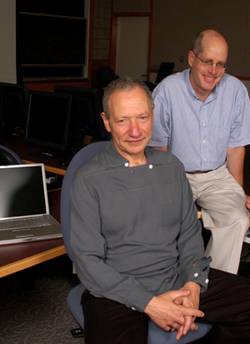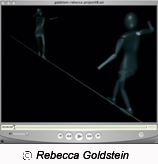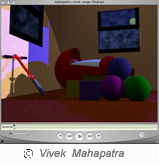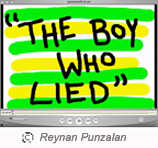CMPU/ART/MEDS 388
Taught by: Tom Ellman and Harry Roseman
 The Course
The Course
What is your course “Art, Science and Criticism” about?
Tom: The course is about exploring the relationship between art and science in the context of computer animation. We addressed questions like:
- What can a scientist learn about science from working with an artist?
- What can an artist learn about art from collaborating with a scientist?
- How does technology influence artistic creativity?
- How do the demands of artists provide challenges for computer scientists?
Harry: Don’t forget it is called, “Computer Animation, Art, Science and Criticism”. So it is ostensibly a computer animation course. This course puts as much emphasis and importance on concept, the visual manifestation of ideas, an exploration of the nature of visual language (including issues of abstraction and depiction, illusion and reality), the nature of process, a discussion across disciplines and methodologies (science and art) and the way this medium functions in the culture, as it does on technical skills. Included in the course is an introduction to work in film and animation. This is done with screenings and discussions. An important element of the course is ‘public’ critiques and forums in which the class as a whole discusses these various issues through the lens of the work they produce. Student assignments range through these various ideas and take the form of problem solving as well as mastering the technical skills of computer animation. There are weekly lectures on the technical aspects of the software, straightforward tutorial assignments that are given to acquaint the students with using the software, and assignments that are designed to get the students to think through this medium and software.
The Technology
How does this particular software tool enhance your teaching goals? Why is it better than other technologies or artistic techniques.
Tom: We use the Maya modeling and animation system in the course. It provides a useful tool for developing short computer animated films. It also provides a framework for introducing concepts underlying computer modeling and animation: coordinate systems, models of surface shape, models of lighting, shading, and texture; interpolation techniques, and rendering techniques. It provides a context in which students can come to understand mathematical concepts in a visually concrete setting.
Harry: It is not that Maya, a three-dimensional computer animation software tool, enhances my teaching goals; in a larger sense it is inextricably enmeshed in the conceptualization of the class. Maya itself presents certain parameters and possibilities that have effected the assignments and discussions. We are using Maya because it is state-of-the-art 3-Dimensional animation software. Though complicated, one can utilize it in innumerable ways. The range it contains enables us to try a large variety of solutions. It is not essentially ‘better’ than clay modeling or cartoon animation or painting, but it is particular and enables the student/artist to do specific things.
The lead pencil, egg tempera, bronze casting, oil paint, photography, motion pictures, digital imaging and crayola crayons are all media, all means of representation and all technological developments that have been utilized as tools by artists (and sometimes scientists) and have affected the way images are produced. They have all impacted representation and our sense of reality. This is not a question of better or of progress; there is not a linear development towards a clear improvement throughout the history of art.
I cannot and will not say that from epoch to epoch we have produced art more fundamentally important, better, more intelligent, more humanist than the paintings at Lascaux, Benin bronzes, Chinese ink painting, than the work of Giotto, Van der Weyden, da Vinci, Valezquez, Rembrandt, Vermeer, Cezanne, Godard, Hitchcock, Picasso, Dekooning, Scorsese and others. I would venture to say that artists for the most part working with computer animation have not as yet produced work of this caliber. But wouldn’t it be exciting to approach this medium with the expectation of this possibility and not to always aim for the effect and entertainment oriented work that we have come to expect from it? – to ask the hard questions and push the work, the process and the discussion to see where it might take us.
The Student Response
How have your students responded to your use of technology?
Harry: The use of this technology does not come as a surprise to the students. They have taken this class to get to work with this technology. I think what has surprised some of the students are the kinds of things I talked about before; that is, the scope of some of the larger issues and goals that we dealt with in the course. The technology was an integral part of the whole discourse and process. The relationship to technological and art issues varies quite a lot depending on the student. The main constituencies of the class were Computer Science and Studio Art Majors, with students from Art History, Film, Anthropology, Astronomy, Biopsychology, Cognitive Science, Urban Studies, as well as independent majors in Animation and Media Studies. The adjustments and responses to various aspects of the class, technology included, differed by discipline as well as by individual inclinations.
The Challenges
What are the challenges you faced teaching this class for the very first time?
Tom: The biggest challenge was teaching students enough of the mathematical and computational techniques underlying Maya so that they could use the system to do genuinely creative and original work. Another challenge was finding a way to for a scientist and artist to collaborate, given their different ways of thinking and their different teaching styles.Harry: The challenges for me were very particular. I had to acclimate myself to the technology and the software as well as an understanding of how to construct a visual language through this medium that also takes into account fundamental visual tenants. One of the aspects of this course is that it was and is being conceived by two people from different disciplines. The discussions between Tom Ellman and me are another component in this undertaking, the juncture (and sometimes dis-juncture) between studio practice and scientific method. I was hoping that those discussions, especially as they manifested in the early stages of our relationship when we were more lost in each others sphere, would be part of the class. The challenge is to keep those kinds of inquiry in the present tense.
Logistically the class was very complicated. How to do everything we were hoping to accomplish in two weekly two-hour sessions over the span of a term? We were sometimes more and sometime less successful at pulling that off. After the first few weeks we realized some of those expectations were overly optimistic and we had to pare down what we could accomplish during the class sessions. Like any new class there is an interesting trade off between tight organizational structure and being a part of the excitement of an undertaking that is being formed at the moment, by the teachers and by the students.
Continuous fundamental assessment will be a part of this class for some time, so I am not too worried about that loss of excitement. I was very impressed with the student’s participation in this process and the level and amount of work they accomplished.
I still have much to learn about the technology, about animation and about this course, which will be ongoing. This will continue to be a challenging course for me, for the students and I assume for Tom Ellman. That being said I think we will trim a little from the course so that we are not all riding on a bullet train non-stop for the entire term.
New Directions
Are there any new directions you would like to explore next Spring, other new things you would like to try out?
Tom: We would like to start using RenderMan, a very powerful rendering application that can manage large rendering jobs through a cluster of Silicon Graphics machines, like the ones we have at the Sci Vis Lab.
Using the 3D scanner would be interesting, especially since it would let students work in clay to start, then scan a clay work and move to the virtual reality medium in a tool like Maya
Harry: There will be much tweaking of the methodologies we have used this past term.
As far as new additions and directions, for example, I would love to introduce other kinds of voices/visual languages to the Maya matrix through the use, for example, of drawing, photography and physical sculpture. This might be accomplished by flat scanning, the use of Photoshop and by the use of the 3-D scanner. Within the context of the assignments some students this first term have brought in some of these other vocabularies. I would hope we could explore editing software and possibly sound sometime in the future. We will continually be faced with what it is possible to accomplish in one term. One of the things we did, which turned out to be rather successful, was to have the students make flip-books. It was a way to have them deal with fundamental issues of image, movement and process. I bring this up here as one example of reminding the students that while embracing and utilizing this technology it is important not to be blindly seduced by it, and that it is possible to accomplish much without using everything at our disposal. Many of the assignments had restrictions as to what processes could be utilized. What I am saying here is yes there are a number of new processes, technologies, and methodologies I would like to try out in the future but that more is not always better.



